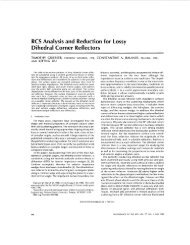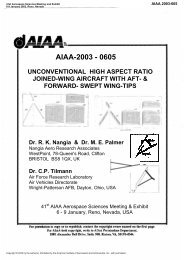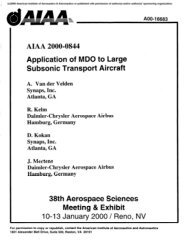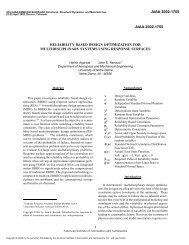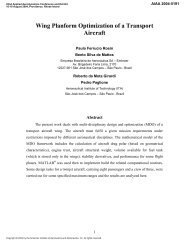The design report
The design report
The design report
Create successful ePaper yourself
Turn your PDF publications into a flip-book with our unique Google optimized e-Paper software.
<strong>The</strong> nose section of the fuselage consists of a smaller nose rib connecting to a fuselage<br />
basic rib with two longerons, a 4mm paulownia top plate and two centre plates. <strong>The</strong><br />
centre plate runs throughout the fuselage, only stopping at the centre of the back<br />
tapered tail section of the fuselage. This is to ensure that there will be no geometrical<br />
twist in the fuselage body when assembling the whole fuselage.<br />
<strong>The</strong> connection of the nose rib to the fuselage body was simple. It was then found out<br />
that the thrust the motor was producing and the torsion it produces was a little too<br />
risky for the connection to be left alone. This is because other than glue, there was<br />
nothing there to stop the nose rib from popping out from the connections. <strong>The</strong> team<br />
then decided to drill two tiny holes near the edge of the nose rib and tied wires around<br />
it to the other rib of the fuselage. This will then stop the nose rib from moving together<br />
with the motor and away from the fuselage.<br />
Figure 4.1.203: <strong>The</strong> fuselage body<br />
Figure 4.1.204: Top view<br />
<strong>The</strong> third rib of the fuselage is connected to the nose landing gear. Its job is solely to<br />
take the load from the landing gear during the landing of the aircraft. This is also as<br />
forward as the battery could move in the fuselage. <strong>The</strong> fourth rib is there just to add<br />
structural strength to the fuselage. As you can see from figure 4.1.203, there are 6








![Introduction to RF Stealth [Book Review] - Antennas and ...](https://img.yumpu.com/16857890/1/190x245/introduction-to-rf-stealth-book-review-antennas-and-.jpg?quality=85)

